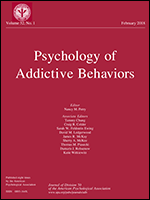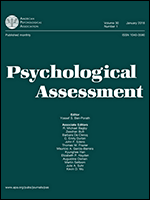Measures & Methodology

In light of a rapidly changing political climate that has increased the accessibility of cannabis products while reducing perceptions of use related risk, the measurement and psychometric validation gap for cannabis use and associated problems, represents a critical knowledge gap (National Academies of Sciences Engineering and Medicine, 2017). I have begun to address this gap using data from several independent projects to evaluate the reliability, structural validity, and construct validity of widely used cannabis problem measures as well as the day-level risks associated with certain patterns and modes of cannabis consumption.

Although the Marijuana Problems Index (MPI) is widely used in studies with college student samples to reflect a unidimensional measure of cannabis-related problems, no studies have assessed the psychometric properties of the MPI in a college student population. The current study sought to resolve this gap in a sample of 879 college students reporting past year cannabis use. Confirmatory factor analyses were used to test the factor structure of the unidimensional 23- and 18-item MPI and measurement invariance across gender. Bivariate correlations between the final factors, cannabis use history/frequency, and other substance use outcomes were used to examine concurrent and discriminant validity (i.e., versus non-cannabis outcomes). The 18- (but not the 23-) item MPI demonstrated good model fit, measurement invariance across gender, adequate internal reliability, as well as concurrent and discriminant validity. Results support the use of the 18-item MPI over the 23-item MPI for conceptualizing problematic cannabis use, including the testing of gender specific differences, among college students. Findings also reinforce the importance of evaluating the psychometric properties of widely used measures across samples.

Associations of mode of administration on cannabis consumption
and subjective intoxication in daily life
Cloutier, R. M., Calhoun, B. H., & Linden-Carmichael, A. N. (2021). Psychology of Addictive Behaviors.
Objective: As cannabis products are becoming increasingly available and young adults are increasingly using vaporizers to consume cannabis, there is a need to understand how this population is using different modes of administration and the extent to which specific modes are associated with differential cannabis use outcomes. Toward this end, the current study characterized predictors of cannabis mode of administration and examined how consumption levels and subjective intoxication vary as a function of mode of administration in daily life.
Method: Participants were 106 young adult cannabis and heavy alcohol users (51% female) who completed up to 14 daily diaries (n = 1,405 person days). Each day, participants reported whether they used any cannabis and, if any, which mode(s) were used, number of hits used per mode, overall subjective intoxication, and the socio-environmental context in which they used cannabis.
Results: Across all cannabis use days, Bong-Only and Vape-Only days were the most common, followed by Multimode, Joint-, Pipe-, and Blunt-Only days. Participants reporting a greater proportion of cannabis use days were more likely to report Bong-Only and Multimode days than Vape-Only days. Compared to Vape-Only days, participants reported fewer hits on Bong-Only days and more hits on Blunt-Only, Pipe-Only, and Multimode days. Participants felt more intoxicated on Bong-Only days than Vape-Only days.
Conclusions: Mode-specific associations with cannabis consumption and subjective intoxication levels suggest assessing modes of administration may be a meaningful way to guide individual and public health intervention efforts.

Development of the A-DISS rejection task to demonstrate the unique and overlapping affective features of social anxiety and depression
Cloutier, R. M., Bilsky, S. A., Baxley, C., Anderson, K. G., & Blumenthal, H. (2020). Cognitive Therapy and Research. Advanced Online Publication. doi: 10.1007/s10608-020-10152-x
Background: Social anxiety and depression are prevalent, often comorbid disorders, associated with poor psychosocial functioning. Experimental psychopathology approaches can clarify the transdiagnostic mechanisms underlying these disorders, but most laboratory tasks are limited. We developed and validated the Audio–Dialogue Inductions of Social Stress (A-DISS) experimental task to model real-time rejection sensitivity in a realistic and developmentally relevant context. Participants are asked to imagine overhearing peers at a party talking badly about them (Rejection) or a teacher at their school (Neutral). Findings provide preliminary validation of a novel peer rejection task for research on understanding the affective experience of real-time rejection overall, especially for those with elevated social anxiety and depression. That, social anxiety and depression symptoms each uniquely moderated the effects of Rejection exposure on similar affective states, suggests individuals with SA or depression may benefit from interventions targeting specific reactions to rejection/stress and transdiagnostic risk factors.

Development and Initial Psychometric Validation of the Brief - Caffeine Expectancy Questionnaire (B-CaffEQ)
Kearns, N. T., Blumenthal, H., Natesan, P., Zamboanga, B. L., Ham, L. S., & Cloutier, R. M. (2018). Psychological Assessment, 301 1597-1611
Caffeine is the most widely available and consumed psychoactive substance in the United States. Extant work indicates that across substances, use expectancies play a marked role in the development and maintenance of consumption patterns. Despite a burgeoning line of etiological and intervention-oriented research focused on expectancies (e.g., alcohol), there is a limited literature regarding caffeine use effect expectancies, specifically. To facilitate this work, the Caffeine Expectancy Questionnaire (CaffEQ) was developed and psychometrically validated; however, the length of the CaffEQ (i.e., 47 items) may hinder widespread adoption of this tool. As such, the current study provides an initial psychometric validation of a brief, 20-item version—the Brief-Caffeine Expectancy Questionnaire (B-CaffEQ)—in a multiethnic sample of undergraduate students (N = 975). Results showed that the B-CaffEQ replicated the 7-factor structure of the original CaffEQ using both constrained (confirmatory factor analysis) and less constrained (exploratory structural equation modeling) structural models and evidenced good internal consistency across subscales. The B-CaffEQ also demonstrated concurrent validity with caffeine use frequency indices, replicated and extended convergent validity between caffeine expectancy subscales and related behavioral and psychological constructs, and demonstrated discriminant validity with other related, but notably distinct, stimulant use metrics (e.g., cocaine, Ritalin). Lastly, the B-CaffEQ appears to provide an invariant measure of expectancies across types of caffeine users. These findings indicate that the B-CaffEQ is a reliable assessment of caffeine use effect expectancies, with acceptable-to-good psychometric properties—comparable in length to other substance use expectancies measures—that may be more readily incorporated into research and clinical settings.

Test-Retest Reliability of the 7-Factor Motives for Playing Drinking Games (MPDG) Scale and its Associations with Drinking Game Behaviors among Female College Athletes
Zamboanga, B. L., Kearns, N. T., Olthuis, J. V., Blumenthal, H., & Cloutier, R. M. (2019). Journal of Clinical Sport Psychology, 13, 580-592
Drinking games (DGs) participation is prevalent among college-attending emerging adults. Research also suggests that student-athletes play DGs more frequently than non student-athletes, but what motivates student-athletes to participate in DGs is not well understood. Using data from a larger longitudinal study with Division III female athletes, we examined the test-retest reliability and minimal detectable change of the revised 7-factor Motives for Playing Drinking Games (MPDG) measure, and explored how its subscales were related to DGs behavior across two annual timepoints (n = 49). Results indicated that the MPDG shows adequate test-retest reliability over a one year period among student-athletes. Controlling for age and general alcohol consumption, conformity motives were positively associated with DG consumption at timepoint 1, whereas the DG motives of enhancement/thrills and boredom were positively related to DG consumption at timepoint 2. Implications for future research directions on motives for playing DGs and DGs behavior among student-athletes are discussed.


